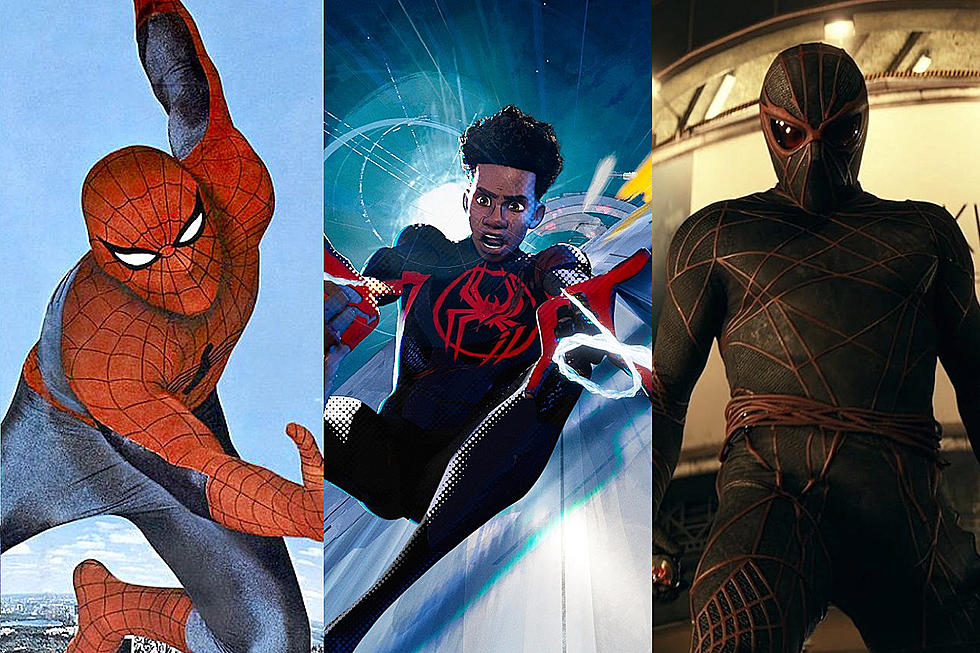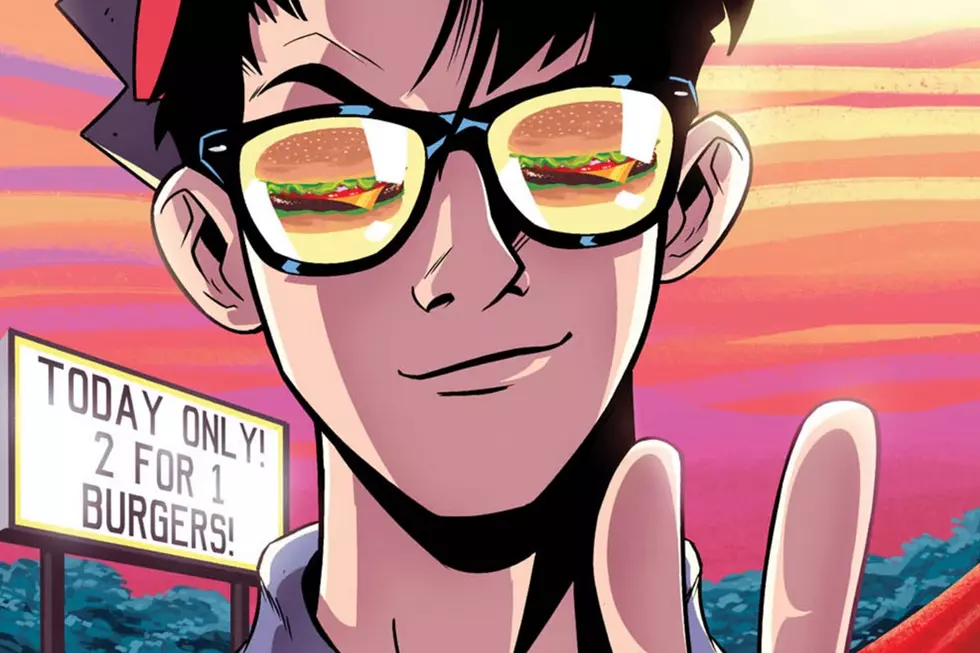
More Than Just Crime: Five Noir Comic Books You Need To Read
The idea of "noir" generally evokes a certain image in the modern audience: black and white, guns and dames, crimes and lowlifes. Real noir, however, goes deeper, exploring the nooks and crannies of fear and desperation. Crime is a common outlet for this sort of storytelling, but there are as many types of noir as there are genres of fiction.
Obviously noir lends itself to the graphic visual language of comic books, as exemplified in recent years by the the work of Ed Brubaker and Sean Phillips in titles like Sleeper, Criminal and Fatale, not to mention the classic Sin City work of Frank Miller and Darwyn Cooke's Parker series. Most of us are already intimately acquainted with those creators' distinctive brands of noir, so in this piece we're taking a look at five other titles that might be new to you. All of them cover a few of the noir bases, starting with the type that you're probably most familiar with and ending up on, as most things do at ComicsAlliance, Batman.
- 1
Torpedo

Developed in 1981 by writer Enrique Sánchez Abulí and comics legend Alex Toth (who was replaced by Jordi Bernet after only two installments due to creative differences), Torpedo serves as one of the best examples of film noir technique being applied to the comics page. Luca Tortelli is a hitman (a.k.a. "Torpedo," thus giving the series its name) who barely gets by most of the time during the Great Depression. Tortelli isn't a protagonist as much as he is a plot device with dialogue, performing his duties with a Mametian sort of directness. These short, discrete stories explore the various ways in which he entraps others and while escaping retribution.
Bernet's known to American audiences for his run on Jonah Hex, All-Star Western and his issue of the DC Comics art project Solo, and it's fascinating to see how clear his artwork was from the beginning, when Torpedo was serialized in Spain's Creepy magazine. His action sequences balance clarity and dynamism perfectly, pulling the reader along with a minimum of fuss or confusion. At the same time, he makes dialogue-rich pages sing with an ambitious use of angles and emotion, rarely repeating a shot or resorting to other tricks of the trade. Bernet's art is a perfect example of balance on multiple fronts. He knows exactly how to pair the light and dark and the cool and melodramatic to create a tone that's perfect for this title.

Even with a lead character that evokes no empathy from the reader, Torpedo is as addictive as comics come. Abulí's savage plotting and Bernet's clear storytelling combine to create a perfect little story engine fueled on bursts of violence and irony. The recent reprint series from IDW features a translation by Bernet's frequent collaborator Jimmy Palmiotti that suits the tone of the work perfectly. I can't recommend reading a slough of these in a row, but as a late-night treat, it's hard to imagine a more perfect dose of nastiness.
(I feel obligated to note that there is no small amount of misogyny and racism in these stories. It's not just the fact that Torpedo is set in the 1930s; many European comics from the '70s and '80s reveled in transgressive storytelling.)

- 2
Revival

I'm not going to lie: when I first heard about Tim Seeley and Mike Norton's "rural noir" series Revival, my eyes rolled. Did we really need another zombie comic, and one written by the guy behind the (ironically, yes, but...) exploitative Hack/Slash at that? I like Mike Norton's art an awful lot, though, so I gave the first volume a whirl and was damn impressed. Seeley and Norton have created a comic that takes the idea of the undead and completely turns it on its ear.
In Revival, the recently deceased of Rothschild, Wisconsin haven't come back as unthinking, unblinking monsters dead-set on murdering everyone. As a matter of fact, they come back fairly intact, which is the actual problem. Revival deals with the ramifications of the mysterious incident at a personal level, focusing primarily on the Cypress sisters, Dana and Martha. Dana's an officer in the police department; Martha who recently came back from the great beyond. As you can imagine, they have quite a bit to talk about, even as the town finds itself fraying under the pressures both external and from within.

Seeley's scripting is natural and willing to wander just a bit to help pull the reader in further. Nothing's every extraneous, just a bit of a flourish on a story that gets larger as you move along. The art might seem like a poor match at first blush, but it's soon obvious how smart it was for these two creators to come together. Norton's human touch throughout the series helps sell both the horrific and the humorous and provides a strong argument against those that decry "cartoonish" art in their funnybooks. There's a touch of EC greats like Johnny Craig and Jack Davis in his line and his faces in particular are a delight.
It's equal parts Coen Brothers and George Romero: funny, dramatic and terrifying. It's been collected in two trade paperbacks as of this writing and they're definitely worth buying.

- 3
Dark Entries

Part of the late Vertigo Crime line, a series that didn't get quite the traction that parent company DC Comics was hoping, novelist Ian Rankin's debut comics script Dark Entries is a Hellblazer story that uses reality TV as a backdrop. Anti-hero protagonist John Constantine is convinced by a producer to participate in an Agatha-Christie inspired horror program, where six strangers see who can last the longest in a massive "haunted house" where they're trying to find a grand prize...if they can last long enough. The twist is a typically Hellblazer sort of moment, the same sort of thing that would later show up in films like Cabin in the Woods, but it works very well in this standalone graphic novel.
Rankin's writing is definitely that of a novelist who's adjusting to a new medium, but Loveless's Werther Dell'Edera really shines with a rough-hewn, European style that helps unsettle the reader in a manner not a million miles away from Guy Davis. There's a very deliberate use of light and darkness and his layouts are comfortable and workmanlike in a way that helps sell the horror as it comes. Like Eduardo Risso (who I'll talk about in a moment), he's fond of cutting away to moody details that help sell the moment. He's the sort of artist I'd like to see getting more work in American comics, recalling Declan Shalvey in places with his gritty, human cartooning.

Dark Entries is a nasty (in the best way) piece of horror noir whose artistic successes beat the occasional bit of clumsy dialogue and slightly out-of-character lead. In fact, with a character whose history is as long and as daunting as Constantine, it could even serve as a bridge for the curious, especially if they're fans of the Rebus novels.
- 4
TEOTFW

TEOTFW (an abbreviation for The End Of The F***ing World) is a nihilist tone poem by Ignatz Award-winner Charles Forsman. The story may seem familiar — Alyssa is in love with the sociopathic James, a young man who's deeply broken but somehow compelling in that way that certain teenagers are, but the end results are startling in their originality. Forsman takes the artistic tropes of Peanuts and the sociopathic bent of works like A Clockwork Orange and blends them to startling effect.
The collision of clean cartooning and brutal violence brings to mind classic film noir b-pictures like The Naked Kiss, where Sam Fuller would take very basic, compositions and infuse them with a sense of dread with thoughtful angles and an attention to dialogue that lets even the most brightly-lit moment become horrific. You never know what's going to happen when you turn the page in TEOTFW; it's a wry, occasionally very insightful look at a particular sort of relationship.
It would be easy to compare this to Oliver Stone's Natural Born Killers if it weren't such a better example of using a medium's strengths to tell a story. From Alyssa and James's first fumblings in the bedroom to the appearance of a satanic cop hell-bent on revenge, Forsman's artistic choices draw the reader in further.

- 5
Batman Noir: Eduardo Risso

With a high-contrast, perfectly-detailed art style, Argentine comic book creator Eduardo Risso became synonymous with the crime comic in the United States with 100 Bullets, his Vertigo title with writer Brian Azzarello. That comic has recently been revived in the form of a miniseries dedicated to series regular Brother Lono, which showed that the duo's love of their characters had not dulled a bit in the intervening half-decade. In fact, it seems like their 2011 collaboration Spaceman might have let them work out their niceties entirely and focus on the seedier stuff.
It seems logical, then, that if you make comics about brutal criminals, you'd want to make comics about their opposition. The recent Batman Noir: Eduardo Risso deluxe hardcover collects Azzarello and Risso's entire output featuring the Dark Knight, stripped completely of color and presented in harsh black and white. This is the first time I'm aware of that a major publisher has done this sort of presentation for a modern superhero comic, and while Risso's regular colorist Patricia Mulvihill is no slouch, getting to see Risso's work in its unadulterated form is a real pleasure. I just wish I could say the same about the actual comics contained within.

Risso is his usual top-flight self, managing to make deep blacks a trusted ally for the sake of storytelling, drawing the reader's focus where it needs to go and making flawless choices in shot selection and how to depict action. You're never bored looking at a page created by Risso, as he takes you on a trip through the environment, spotlighting tiny things that might be lost when presented in a splash or other configuration.
You could easily debate Azzarello's take on Batman, though. He comes off as a brutal thug who seems to do very little in the way of detective work and instead relies on intimidation to get the answers he seeks. While this is a mode of Batman that a lot of people seem to like, it doesn't sit particularly well with me. Even noir flourishes and character moments like Bruce Wayne talking on the phone with the then-commissioner as he cooks a steak feel as if they wandered in from another story entirely.
However, the third story, part of the universe-resetting Flashpoint event, seems to be tapping into something special. The Bruce-Wayne's-father-as-Batman arc manages to work well as superhero noir, likely because it revels in the excesses that both creators are known for while taking place in a discrete reality. It also places Jim Gordon front and center, which gives the reader a lens through which they can see how deeply broken every character is.
If you're searching for an in-depth exploration of Batman, Batman Noir is certainly not the place from which you should start. However, as a stripped-down look at a master comics illustrator working with an icon to create atmosphere, it's well worth consideration.
(For the sake of completeness, I feel I should mention the out-of-print Elseworlds Gotham Noir is a fine example of the idiom, especially as it's a crime-and-spandex comic by Ed Brubaker and drawn by Sean Phillips.)

- Bonus
Top 10 Underrated Batman Villains
More From ComicsAlliance






















